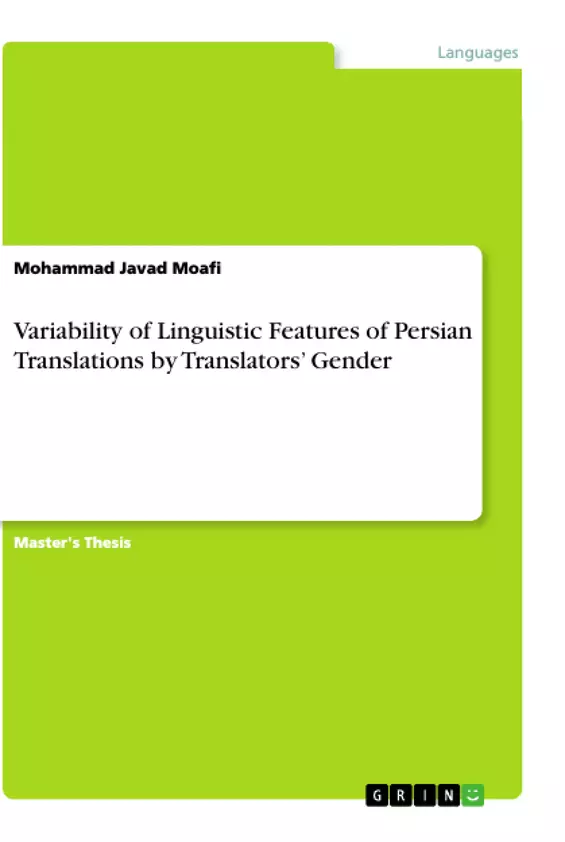The purpose of the study was to investigate whether there is a meaningful relationship between translators’ gender and their translations in terms of such linguistic features as reference, conjunction, misspelling, SL intrusion, punctuation, verbs and sexually-explicit terms. For that reason, the same sample English text was imparted to both female and male translators to be rendered into Persian to ascertain if they vary linguistically, and if they do so, what areas are more frequently different. The organizational factors, rather than pragmatic ones, of language, namely, grammatical as well as textual dimensions were scrutinized in the study. The participants were 30 male and 30 female undergraduate senior students of English at three universities in Qom, Iran. These 60 participants were selected out of 150 students who scored as high as 6 in the IELTS given to them and showed their English proficiency. By analyzing the data elicited descriptively from each translation, primarily, via t test; only 6, out of 22, variables demonstrated a significant difference between translations made by both genders contributing to the research. Thus, although these 6 variables verify the meaningful relationship between translator’s gender and translation, these elements are not enough to indicate that grammar and discourse of translations are significantly different. In addition to raising awareness and developing the scope of translation studies, the present study has several implications. As a case in point, a text with a particular feature may be assigned to a specific gender to be better translated.
Inhaltsverzeichnis (Table of Contents)
- DECLARATION
- DEDICATION
- Table of Contents
- ACKNOWLEDGEMENTS
- Abstract
- Chapter One: INTRODUCTION
- 1.1 Overview
- 1.2 Statement of the Problem
- 1.3 Significance of the Study
- 1.4 Domain of the Study
- 1.5 Research Questions
- 1.6 Research Hypotheses
- 1.7 Definition of Key Terms
- Chapter Two: LITERATURE REVIEW
- 2.1 Overview
- 2.2 Translation Studies
- 2.3 Equivalence
- 2.4 Gender Studies
- 2.5 Gender and Discourse
- 2.6 Gender and Feminist Linguistics
- 2.7 Gender and Translation
- Chapter Three: METHODOLOGY
- 3.1 Overview
- 3.2 Design
- 3.3 Participants
- 3.4 Materials
- 3.5 Procedures
- Chapter Four: DATA ANALYSIS AND RESULTS
- 4.1 Overview
- 4.2 Data Analysis and Results
- Chapter Five: DISCUSSION AND CONCLUSION
- 5.1 Discussion
- 5.2 Conclusion
- 5.3 Implications of the Study
- 5.4 Limitations of the Study
- 5.5 Suggestions for Further Research
- References
- Appendix I
Zielsetzung und Themenschwerpunkte (Objectives and Key Themes)
This thesis explores the impact of translator gender on the linguistic features of Persian translations. It aims to investigate whether there are any significant differences in the translations produced by male and female translators.
- The role of gender in translation studies
- The impact of translator gender on linguistic choices in Persian translations
- The relationship between gender and discourse in the context of translation
- The application of feminist linguistics to the analysis of translation
- The potential for bias and inequality in the translation process
Zusammenfassung der Kapitel (Chapter Summaries)
- Chapter One: INTRODUCTION: This chapter provides an overview of the research topic, defines the problem, and outlines the significance and scope of the study. It also presents the research questions, hypotheses, and key terms.
- Chapter Two: LITERATURE REVIEW: This chapter examines relevant literature from various fields, including translation studies, gender studies, and feminist linguistics. It explores the concepts of equivalence, gender and discourse, and the impact of gender on translation.
- Chapter Three: METHODOLOGY: This chapter details the research design, participants, materials, and procedures employed in the study. It outlines the approach taken to collect and analyze data.
- Chapter Four: DATA ANALYSIS AND RESULTS: This chapter presents the findings of the study, analyzing the collected data to identify any significant differences in the translations produced by male and female translators.
Schlüsselwörter (Keywords)
Key terms and focus topics of this study include translation studies, gender studies, Persian language, linguistic features, gender and discourse, feminist linguistics, translation quality, equivalence, bias, inequality, and empirical research.
- Quote paper
- Mohammad Javad Moafi (Author), 2010, Variability of Linguistic Features of Persian Translations by Translators’ Gender, Munich, GRIN Verlag, https://www.grin.com/document/536488



